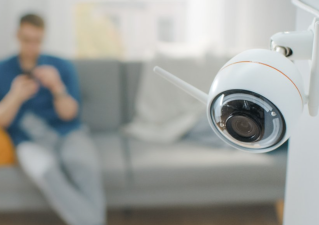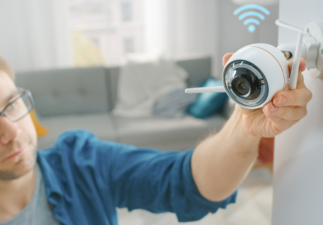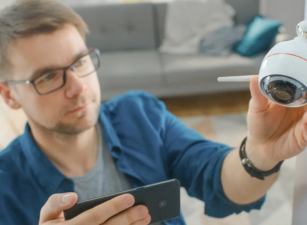Smart home devices have become increasingly popular in recent years, promising convenience and automation to improve our daily lives. However, as more and more smart home devices are connected and collect and transmit more and more data, people are increasingly concerned about privacy and security risks in their use.
Smart home devices have become increasingly popular in recent years, promising convenience and automation to improve our daily lives. However, as more and more smart home devices are connected and collect and transmit more and more data, people are increasingly concerned about privacy and security risks in their use.
What are smart home devices?
Smart home devices are the specific application of Internet of Things (IoT) technology in the home environment. They are connected to the Internet to realize automation and intelligent control of various aspects of the home. These devices cover a wide range of categories, from smart thermostats, security cameras, smart door locks, lighting systems, to smart refrigerators, washing machines and other home appliances. They can usually be remotely controlled through smartphone applications and can be seamlessly integrated with virtual assistants such as Amazon Alexa or Google Assistant to provide users with a more convenient operation experience.

Security risks of smart home devices
Although smart home devices are powerful, they also have some potential security risks, which are mainly reflected in the following aspects:
- Data leakage risk
The large amount of user data collected by smart home devices may be at risk of being leaked during transmission and storage. If there are security vulnerabilities in the cloud storage system of the device manufacturer or the data is intercepted during transmission, the user's personal information may be leaked. This information may include the user's name, address, contact information, payment information, etc. Once it falls into the hands of criminals, it may cause the user to suffer from risks such as fraud and identity theft.
- Device hacking
Smart home devices are usually connected to the Internet through home networks, which makes them targets for hacker attacks. Hackers can gain access to the user's home network by hacking into smart home devices, and then attack other devices connected to the same network, such as computers, smartphones, etc. For example, hackers may obtain the user's network password by hacking into smart door locks, and then further hack into the user's computer to steal important files and data.
- Device malicious use
Some smart home devices may be maliciously used for illegal purposes. For example, smart cameras may be hacked into to monitor the user's private life, or even used for extortion. In addition, hackers may also control the behavior of smart home devices by hacking into them, creating chaos or malicious damage. For example, hackers may remotely turn off the user's smart thermostat, causing the indoor temperature to be too high or too low, causing inconvenience and loss to the user.
- Devices track user behavior Smart home
During operation, devices will continuously collect user usage data, which can reflect the user's daily behavior patterns and living habits. For example, smart door locks can record the user's entry and exit time, and smart lighting systems can record the user's activity area and time. If these data are improperly collected and used, they may be used to create user behavior profiles, which are then sold to advertisers or other third-party organizations for precision marketing or other commercial purposes, thereby infringing on the user's privacy.
Installing surveillance can easily leak personal privacy
Many people always think that only they can see the surveillance installed at home, but in fact, it is not. Generally, the surveillance equipment at home will upload all the recorded content to the cloud for storage. This data can not only be seen by the device itself, but also by the supplier. A friend who specializes in the sale of surveillance equipment once said that even if they promise not to view the user's data, the data will still be seen.

Safety measures to protect smart home devices
In order to ensure the security and privacy of smart home devices, users can take the following measures:
- Choose a reliable device brand
When purchasing smart home devices, be sure to choose a reputable brand that focuses on privacy and security. Before buying, you can learn more about the product's security and privacy protection measures by reading product reviews, checking user feedback, and consulting professionals. Some well-known brands usually invest more resources in security protection during product design and development, such as using encryption technology to protect data transmission, setting up strict user authentication mechanisms, etc., so as to provide users with more reliable security protection.
- Ensure home network security
The home network is an important channel for smart home devices to connect to the Internet, so it is crucial to ensure the security of the home network. First of all, use a strong password to protect the home network and avoid using passwords that are too simple or easy to guess. At the same time, it is recommended to enable the two-factor authentication function to increase the security of network access. In addition, update the firmware of the router regularly to ensure that its security vulnerabilities are fixed in a timely manner. You can also consider isolating smart home devices into a separate network, separate from the main home network, so that even if the device is hacked, it will not affect the security of the main home network.
- Read the privacy policy carefully
Before purchasing smart home devices, be sure to read the manufacturer's privacy policy carefully. Understand how device manufacturers collect, use, and share user data, and what measures they have taken to protect user privacy. If there is unclear or unreasonable content in the privacy policy, it is recommended to carefully consider whether to purchase the device. For example, some device manufacturers may use user data for marketing purposes or even share user data with third parties. In this case, users need to weigh the convenience of the device against privacy risks.

- Disable unnecessary functions
Smart home devices usually have multiple functions, but not all functions are needed by users. For some unnecessary functions, it is recommended to disable them to reduce the amount of data collected and transmitted by the device and reduce the risk of privacy leakage. For example, if the user does not need the voice recognition function of the smart camera, it can be turned off to prevent the device from collecting the user's voice information.
- Update device software regularly
Device manufacturers usually release software updates regularly to fix security vulnerabilities, improve device performance, and add new features. Therefore, users should check the software updates of their devices regularly and update them in time. You can check whether there are available updates through the mobile app that comes with the device or visit the manufacturer's official website. Timely updating of device software can ensure the security of the device and prevent hackers from exploiting known security vulnerabilities.
- Install antivirus software
Installing reliable antivirus software in the home network can provide additional security protection for smart home devices. Many modern antivirus software suites include smart security features that can automatically detect and block malware intrusions, protecting all devices on your home network from attack. For example, some antivirus software can monitor network traffic in real time to identify and block suspicious network connections, preventing hackers from breaking into your home network through smart home devices.

